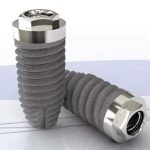
If you are missing just one tooth, a few teeth, or all of your teeth, you can benefit from the use of dental implants.
A dental implant is used to replace a missing tooth, to act as anchors for a bridge, or to aid in the retention of dentures.
By filling in the gaps in your teeth, you will experience improved chewing and eating. This may lead to better overall health from better nutrition. Often, missing teeth causes low self-esteem, so having dental implants with crowns also improves self-confidence and mental health. When you are missing a tooth, the neighboring teeth may shift into the empty space.
By filling the space with a dental implant and crown, the positions of the neighboring teeth are better maintained. And, unlike dentures and bridges, a dental implant can better maintain normal bone resorption, limiting bone recession.
The field of dental implants has greatly improved, even over just the past few years, making the process more comfortable and the time commitment shorter. The in-clinic procedure for dental implants is now fast and virtually painless. And the use of implants does not require work to be done on neighboring teeth.
If you are interested in dental implants, start by scheduling a dental consultation. The dentist utilizes radiographs, such as panoramic X-rays or CT scans, along with a visual assessment and dialogue to determine if you are a good candidate for a dental implant.
A dental implant is comprised of 2 parts, not including the tooth-like crown.
During the first surgical visit, the fixture is installed. This part of the implant looks like a small screw and is usually made of titanium since titanium has been found to integrate well with bone. After this visit, your gums are closed over the fixture and time is given to let the bone heal. Usually, the bone has healed enough after 2-3 months that the second part of the implant may be installed.
At the second surgical visit, your gums will be opened and the abutment part of the implant is installed onto the fixture. Again, time is necessary to allow your gums to heal, so the crown or dentures that will connect to the implant will fit properly. After as little as two weeks of healing time, fabrication of prosthodontics (crowns, bridges, or dentures) may begin. When the prosthodontics are ready, they may be delivered and you can enjoy your new smile.
In just a matter of months, you could be smiling brighter with new dental implants.



